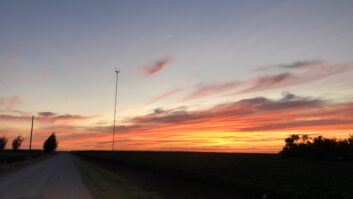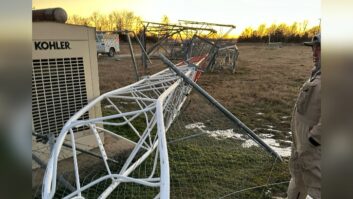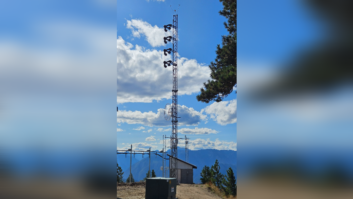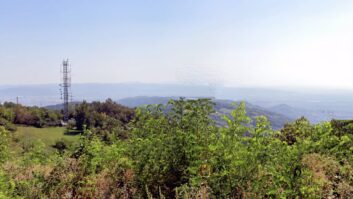The Author Says This Particular Legend May be a Big Flap Over Nothing
This is a strange personal coincidence, involved as I am in promoting fair and reasonable tower and antenna regulation as chairman of the National Antenna Consortium and having grown up in Eau Claire, Wis., home of the so-called “worst bird tower-kill incident of all time.”
It is nonetheless true, and I believe my experience (or more precisely, the lack thereof) with the incident gives me the opportunity to ask some pointed questions about the veracity of the tower-kill story.
The questions are important given the recent Fish and Wildlife recommendations that all towers should be under 200 feet and without lighting, and the announcement of suits by at least one group to prevent the FCC from granting licenses that would require tall and lighted towers because of the danger to migrating songbirds.
In 1974 an Eau Claire tower reportedly killed 30,000 birds in a single night.
Eau Claire does have one large tower, about 1,100 feet, belonging to WEAU(TV). By 1974, the TV station transmitted from a 2,000-footer 30 miles to the south. There was, and I believe still is, a 14-bay FM, belonging to WBIZ(FM), and a series of RPU, STL, two-way and other antennas on the tower.
While the reports never say which tower, it’s hard to imagine any other. Likewise, the type of bird(s), if mentioned, is usually reported as “song birds.”
Towering insanity
Over the years, I’ve been involved in a number of tower constructions, and almost all of them have involved at least some level of regulatory insanity. Once, at a public hearing, a surprise Russian RFR expert was spirited in from Moscow to testify that a UHF transmitter we wanted to build in the mountains posed a serious health threat to the lone nearest resident 1.3 miles away … at least by Russian standards. That wasn’t the weirdest tower regulation story, but it’s easy to tell with brevity. Hence, the responsibility I feel to do something to promote fair and reasonable tower and antenna regulation, and thus my voluntary work with the NAC.
I’m proud to call Eau Claire my hometown. I graduated from E.C. Memorial High School in 1973, and spent my freshman year at the University of Wisconsin-Eau Claire, working part-time as a very bad DJ and neophyte technician at, you guessed it, WBIZ, whose antenna was on said tower.
Worse, I was messing with ham radio and constantly biking over to Bushland Radio Specialties, located next to the Tower Bar, both less than a stone’s throw from the base of said tower.
I can’t remember if it was fall or spring 1974, but I do remember the story of the bird kill on the 10 o’clock news. They couldn’t have missed it, as the TV studio isn’t too much farther than the bar is from the tower, and the 16-foot studio door was always open outside in lieu of air conditioning. As I recall, it involved migrating geese (the Bob Dylans of songbirds, I suppose) on a foggy night.
I recall the use of the word “dozens,” but never “30,000” until years later. Geese are fairly big birds, and travel in a distinctive “V” formation. As a kid, we counted the geese, and about 100 to 200 in each formation is normal.
Stunt geese
Having 150 to 300 of these formations, each competing for flight plans to achieve a near 100-percent fatality rate in one foggy night, seems somewhat unbelievable to me. Paint yourself a mental picture of all these formations of geese, a quarter-mile across, flying away from the tower, regrouping in the fog, rotating slowly around an imaginary pivot point miles away, relocating the tower (all the while out of sight) and making run after suicide run; each pass picking off a few birds at a time.
And why only in 1974? Why not every year, or every 10-years? Did tower avoidance become part of the survivors’ genetic memory? Certainly the weather conditions that lead to this disaster have been repeated somewhere within the last quarter century.
A compressed goose takes up a good half a cubic foot – a bit smaller than the famed WKRP frozen turkeys. I don’t recall seeing, hearing or hearing about the 160 or so 10-yard capacity dump trucks that would be needed to haul them away. Certainly this would have made the National Enquirer? Gee, if it took 4 hours, that’s 120-bird collisions and falls per minute, a “stranger than science” 4-hour-long dead-bird blizzard in the fog. The stress on the tower had to at least damage the radomes and lamps.
Calculating in the spread pattern, the roof and car damage would be notable, too. A limp goose hitting the windshield of a car from an 800-foot power dive is serious, and Hasting’s Way, directly below, is a 35-mph, four-lane, heavily traveled major highway (U.S. 53). Certainly, as the density of dead birds and disabled cars built up, traffic would have ground to a halt.
The average car at the bar (and there would have been about a dozen) would take two hits. Across Hasting’s way, Wagner’s Bowling Alley surely would have had its 50 or so patrons up in arms. And Roland Bushland, who gave me good prices on things like caps and tubes, didn’t have anything to say about it, and I worked for his FM station most of 1974. Heck, Roland even had pictures of significant snowfalls tacked up on the wall in the sales area – a pile of birds would have fit right in. He would have talked about this for years even if his camera didn’t work.
It is possible the geese locked their wings and glided to the horizon … but then they would be a mile from the tower and the affected area would be even bigger.
I’m not having a lot of trouble with the idea of 30 or even 300 birds that could have died in one night in 1974, although in my entire life around towers, I have yet to see even one tower-killed bird. It’s the 30,000 I need explained.
Surely there must be some article about it in the Eau Claire Leader Telegraph. Heck, half the kids in my UW-EC journalism classes had to scratch to string stories for 3 cents per printed line to get class credit. Someone must have taken a picture, drove the dump trucks or left the Tower Bar to slog through a wall of dead birds and remembered it.
It’s not the kind of thing you forget. It would be at least as memorable as that Hitchcock movie, “The Birds.” The ’70s, I do remember. Certainly “The X-Files” would have borrowed the plot as the series dragged on.
The real predators
I have, however, watched birds of prey work from a tower, killing off small furry mammals and tiny birds day after day. The 150-foot perching point probably gives birds an unfair advantage. I have had barns for some time, and I’ll testify that barn cats are very tough on birds, and cars too. Honestly, each cat we’ve had surely dispatched more birds than all the towers I’ve worked with, tall and short, lighted and not. I’m not sure what part of the food chain I should prefer this week.
Even so, my wife and I have a dozen cat-proofed bird feeders and two birdbaths on our place, which we call Whippoorwill Farm. The ham tower and long wires are play toys to the birds. The birds are tougher on the antennas than the antennas are on the birds, from what I can see.
Extraordinary claims require extraordinary proof. Let’s see the cards. Bottom line? I sincerely doubt that the “biggest bird kill” ever happened. Proof should be easy to come by. Crop circles, cattle mutilations and tower bird kills sure look a lot alike from here. I do enjoy www.towerkill.com though.
I want to believe. I’m taping an “X” on my window right now.












